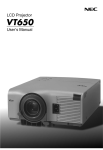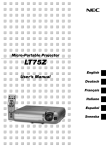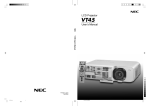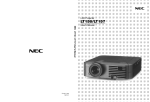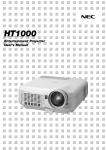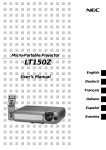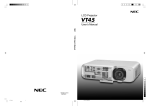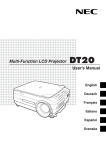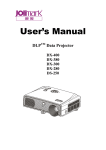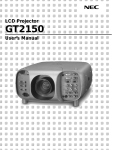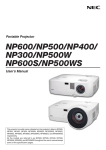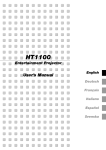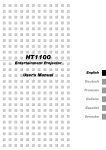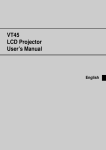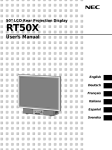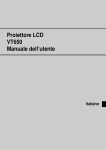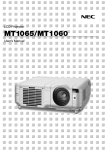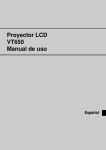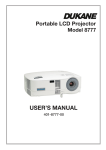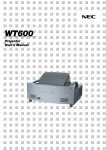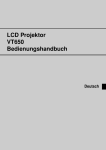Download LCD Projector User`s Manual
Transcript
LCD Projector User’s Manual NEC VT650 User’s Manual Printed in China 7N8P1111 LIMITED WARRANTY GARANZIA LIMITATA Except as specified below, the warranty that may be provided by the dealer covers all defects in material or workmanship in this product. The following are not covered by the warranty: 1. Any product on which the serial number has been defaced, modified or removed. 2. Damage, deterioration or malfunction resulting from; a. Accident, misuse, abuse, neglect, fire, water, dust, smoke, lightning or other acts of nature, unauthorized product modification, or failure to follow instructions supplied with the product. b. Repair or attempted repair by non-authorized persons. c. Any shipment of product (claim must be presented to the carrier). d. Removal or installation of the product. e. Any other causes which do not relate to a product defect. 3. Cartons, carrying cases, batteries, external cabinets, CDROM, or anyaccessories used in connection with the product. 4. Removal or installation charges. 5. Cost of initial technical adjustments (set-up), including adjustment of user controls. These costs are the responsibility of the dealer from whom the product was purchased. 6. Payment of shipping charges. A parte la specificazione seguente, la graanzia che potrebbe essere fornita dal rivenditore copre tutti i difetti di materiali o nella lavorazione in questo prodotto. I seguenti non sono coperti dalla garanzia : 1. Ogni prodotto che ha il numero seriale difettoso, modificato o rimosso. 2. Danni, deterioramento o malfunzionamento risultanti da; a. Incidenti, abuso, cattivo uso, negligenza, fuoco, acqua, polvere, fumo,fulmini o altri atti naturali di tipo naturale, modifiche inautorizzate del prodotto, o errori nel seguire le istruzioni fornite con il prodotto. b. Riparazioni o tentativi di riparazioni effettuati da persono non autorizzate. c. Qualsiasi trasporto del prodotto (i reclami devono essere presentati dal corriere). d. Rimozione o installazione del prodotto. e. ogni altra causa non relativa ad un deficit del prodotto. 3. Cartoni, scatole di trasporto, batterie, armadietti esterni, CDROM, o qualsiasi altro accessorio annesso al prodotto. 4. Carichi di rimozione o installazione. 5. Costi di aggiustamenti tecnici iniziali (set-up), includendo i comandi di regolazione. Il rivenditore dal quale avete acquistato il prodotto è responsabile di ciò. 6. Pagamento delle spese di consegna. GARANTIE LIMITEE Mis à part les point indiqués ci-dessous, la garantie pouvant être couverte par le revendeur comporte l’ensemble des défauts se rapportant au matériel ou aux travaux d’assemblage sur ce produit. Les points suivants ne sont pas couverts par la garantie: 1. Les produits dont les numéro de série a été effacé, modifié ou retiré. 2. Dommages, dégâts ou dysfonctionnement suite à; a. Un accident, mauvaise utilisation, abus, négligences, incendies, dégats dûs aux eaux, à la poussière, à la fumée, aux éclairs ou autres phénomènes naturels, à une modification non autorisée du produit, ou à la non-conformité aux instructions fournies avec le produit. b. Réparation ou tentative de réparation par des personnes non autorisées. c. Toute expédition du produit (les plaintes doivent être adressées à la société de frêt). d. Démontage ou installation du produit. e. Toute autre cause ne se rapportant pas à un défaut du produit. 3. Les cartons, boîtes, piles, caissons externes, CDROM, ou tout autre accessoire utilisé avec ce poduit. 4. Prix de démontage ou d’installation. 5. Coût des réglages techniques de base (mise au point), incluant les réglages des commandes utilisateurs. Ces coûts sont placés sous la responsabilité du revendeur auprès duquel le produit a été acheté. 6. Paiement des frais de transport. BESCHRÄNKTE GARANTIE Außer in den unten beschriebenen Fällen deckt die vom Händler unter Umständen gewährte Garantie alle Material- oder Herstellungsfehler dieses Produktes ab. In den folgenden Fällen wird keine Garantie gewährt: 1. Wenn die Seriennummer des Produktes unleserlich gemacht, geändert oder entfernt worden ist. 2. Bei einer Beschädigung, Beeinträchtigung oder Funktionsstörung, die aus folgenden Fällen resultiert: a. Unfall, falscher Gebrauch, Missbrauch, Fahrlässigkeit, Feuer, Wasser, Staub, Rauch, Blitzeinschlag oder andere Naturereignisse, nicht autorisierte Veränderungen des Produktes oder die Missachtung der dem Produkt beigefügten Anleitung. b. Reparatur oder der Versuch einer Reparatur durch nicht autorisierte Personen. c. Jeglicher Transport des Produktes (die Haftung liegt in diesem Fall bei der den Transport durchführenden Person). d. Entfernung oder Installation des Produktes. e. Jegliche andere Ursachen, die nicht mit einem Defekt dieses Produktes zusammenhängen. 3. Verwendung von Kartons, Transportkisten, Batterien, Außengehäusen, CD-ROMs oder anderem Zubehör zusammen mit diesem Produkt. 4. Entfernungs- oder Installationsforderungen und –kosten. 5. Kosten der technischen Anfangseinstellungen (Setup), einschließlich der Einstellungen der Benutzersteuerungen. Diese Kosten sind vom Händler zu tragen, von dem das Produkt erworben wurde. 6. Bezahlung von Transportkosten. GARANTÍA LIMITADA A excepción de lo que se especifica abajo, la garantía que puede ser suministrada por el distribuidor cubre todos los defectos en material o elaboración en este producto. Lo siguiente no es cubierto por la garantía: 1. Cualquier producto en el cual el número serial haya sido desfigurado, modificado o removido. 2. Daños, deterioro o malfuncionamiento resultado de; a. Accidente, mal manejo, abuso, negligencia, fuego, agua, polvo, humo, relámpagos u otros fenómenos naturales, modificaciones del producto sin autorización, fallas en el seguimiento de las instrucciones suministradas con el producto. b. Reparación o intentos de reparación por personas no autorizadas. c. Cualquier envío del producto (el reclamo debe presentarse al transportador). d. Remoción o instalación del producto. e. Cualquier otra causa que no este relacionada con un defecto del producto. 3. Cartones, estuches de transporte, pilas, gabinetes externos, CDROM, o cualquier accesorio utilizado en conexión con el producto. 4. Costos por instalación o remoción. 5. Costo de los ajustes técnicos iniciales (configuración), incluyendo el ajuste de los controles de usuario. Estos costos son responsabilidad del distribuidor donde se adquirió el producto. 6. Pago de los costos de envío. BEGRÄNSAD GARANTI Garantin som ges av återförsäljaren täcker alla brister i material och utförande med undantag av vad som anges nedan. Följande täcks inte av garantin: 1. Produkter vars serienummer har blivit oläsligt, modifierats eller tagits bort. 2. Skador, försämring eller felfunktion som beror på: a. Olyckor, fel bruk, missbruk, vanskötsel, brand, vatten, stoft, rök, åska eller annan orsak som beror på naturen, icke auktoriserad modifikation av produkten samt underlåtenhet att följa anvisningarna som lämnas med produkten. b. Reparationer eller försök på reparation av icke auktoriserade personer. c. Transportskador (dessa bör riktas till transportföretaget). d. Avmontering eller installation av produkten. e. Övriga orsaker som inte har något samband med produktens fel. 3. Förpackningslådor, bärväskor, batterier, externa höljen, CD-ROMskivor samt andra tillbehör som används tillsammans med produkten. 4. Avmonterings- och installationskostnader. 5. Kostnader för tekniska justeringar (inställning), inklusive justering av användarreglagen. Dessa kostnader är återförsäljarens ansvar där produkten köpts. 6. Betalning för transportkostnader. VT650 LCD Projector User’s Manual English E–1 IMPORTANT INFORMATION RF Interference Precautions Please read this manual carefully before using your NEC VT650 Projector and keep the manual handy for future reference. Your serial number is located under the name plate label on the right side of your VT650. Record it here: WARNING The Federal Communications Commission does not allow any modifications or changes to the unit EXCEPT those specified by NEC Technologies in this manual. Failure to comply with this government regulation could void your right to operate this equipment. This equipment has been tested and found to comply with the limits for a Class B digital device, pursuant to Part 15 of the FCC Rules. These limits are designed to provide reasonable protection against harmful interference in a residential installation. This equipment generates, uses, and can radiate radio frequency energy and, if not installed and used in accordance with the instructions, may cause harmful interference to radio communications. However, there is no guarantee that interference will not occur in a particular installation. If this equipment does cause harmful interference to radio or television reception, which can be determined by turning the equipment off and on, the user is encouraged to try to correct the interference by one or more of the following measures: CAUTION To turn off main power, be sure to remove the plug from power outlet. The power outlet socket should be installed as near to the equipment as possible, and should be easily accessible. CAUTION TO PREVENT SHOCK, DO NOT OPEN THE CABINET. NO USER-SERVICEABLE PARTS INSIDE. REFER SERVICING TO QUALIFIED NEC SERVICE PERSONNEL. This symbol warns the user that uninsulated voltage within the unit may be sufficient to cause electrical shock. Therefore, it is dangerous to make any kind of contact with any part inside of the unit. • Reorient or relocate the receiving antenna. • Increase the separation between the equipment and receiver. • Connect the equipment into an outlet on a circuit different from that to which the receiver is connected. • Consult the dealer or an experienced radio / TV technician for help. This symbol alerts the user that important information concerning the operation and maintenance of this unit has been provided. The information should be read carefully to avoid problems. In UK, a BS approved power cable with moulded plug has a Black (five Amps) fuse installed for use with this equipment. If a power cable is not supplied with this equipment please contact your supplier. WARNING TO PREVENT FIRE OR SHOCK, DO NOT EXPOSE THIS UNIT TO RAIN OR MOISTURE. DO NOT USE THIS UNIT’S GROUNDED PLUG WITH AN EXTENSION CORD OR IN AN OUTLET UNLESS ALL THREE PRONGS CAN BE FULLY INSERTED. DO NOT OPEN THE CABINET. THERE ARE HIGHVOLTAGE COMPONENTS INSIDE. ALL SERVICING MUST BE DONE BY QUALIFIED NEC SERVICE PERSONNEL. DOC Compliance Notice This Class B digital apparatus meets all requirements of the Canadian Interference-Causing Equipment Regulations. 3. GSGV Acoustic Noise Information Ordinance: The sound pressure level is less than 70 dB (A) according to ISO 3744 or ISO 7779. • IBM is a registered trademark of International Business Machines Corporation. • Macintosh and PowerBook are registered trademarks of Apple Computer, Inc. • Other product and company names mentioned in this user's manual may be the trademarks of their respective holders. E–2 Important Safeguards CAUTION These safety instructions are to ensure the long life of your projector and to prevent fire and shock. Please read them carefully and heed all warnings. Installation 1. For best results, use your projector in a darkened room. 2. Place the projector on a flat, level surface in a dry area away from dust and moisture. 3. Do not place your projector in direct sunlight, near heaters or heat radiating appliances. 4. Exposure to direct sunlight, smoke or steam can harm internal components. 5. Handle your projector carefully. Dropping or jarring can damage internal components. 6. Do not place heavy objects on top of the projector. 7. If you wish to have the projector installed on the ceiling: Do not turn off the main power or unplug the power cable from the wall outlet under any one of the following circumstances. Doing so can cause damage to the projector: • Immediately after the power cable is plugged into the wall outlet (when the POWER indicator has not changed to a steady orange glow). • Immediately after the cooling fan stops working (The cooling fan continues to work for 60 seconds after the projector is turned off with the POWER button). CAUTION Avoid displaying stationary images for a prolonged period of time. Doing so can result in these images being temporarily sustained on the surface of the LCD panel. If this should happen, continue to use your projector. The static background from previous images will disappear. a. Do not attempt to install the projector yourself. b. The projector must be installed by qualified technicians in order to ensure proper operation and reduce the risk of bodily injury. c. In addition, the ceiling must be strong enough to support the projector and the installation must be in accordance with any local building codes. d. Please consult your dealer for more information. Power Supply 1. The projector is designed to operate on a power supply of 100-120 or 200-240 V 50/60 Hz AC. Ensure that your power supply fits this requirement before attempting to use your projector. 2. Handle the power cable carefully and avoid excessive bending. A damaged cord can cause electric shock or fire. 3. If the projector is not to be used for an extended period of time, disconnect the plug from the power outlet. Cleaning 1. Unplug the projector before cleaning. 2. Clean the cabinet periodically with a damp cloth. If heavily soiled, use a mild detergent. Never use strong detergents or solvents such as alcohol or thinner. 3. Use a blower or lens paper to clean the lens, and be careful not to scratch or mar the lens. E–3 CAUTION Do not put the projector on its side when the lamp is turned on. Doing so may cause damage to the projector. Lamp Replacement • To replace the lamp, follow all instructions provided on page E-38. • Be sure to replace the lamp when the message "The lamp has reached the end of its usable life. Please replace the lamp." appears. If you continue to use the lamp after the lamp has reached the end of its usable life, the lamp bulb may shatter, and pieces of glass may be scattered in the lamp case. Do not touch them as the pieces of glass may cause injury. If this happens, contact your NEC dealer for lamp replacement. • Allow a minimum of 60 seconds to elapse after turning off the projector. Then disconnect the power cable and allow 60 minutes to cool the projector before replacing the lamp. Fire and Shock Precautions 1. Ensure that there is sufficient ventilation and that vents are unobstructed to prevent the build-up of heat inside your projector. Allow at least 3 inches (10 cm) of space between your projector and a wall. 2. Prevent foreign objects such as paper clips and bits of paper from falling into your projector. Do not attempt to retrieve any objects that might fall into your projector. Do not insert any metal objects such as a wire or screwdriver into your projector. If something should fall into your projector, disconnect it immediately and have the object removed by a qualified NEC service personnel. 3. Do not place any liquids on top of your projector. • Do not look into the lens while the projector is on. Serious damage to your eyes could result. • Keep any items such as magnifying glass out of the light path of the projector. The light being projected from the lens is extensive, therefore any kind of abnormal objects that can redirect light coming out of the lens, can cause unpredictable outcome such as fire or injury to the eyes. • Do not cover the lens with the supplied lens cap or equivalent while the projector is on. Doing so can lead to melting of the cap and possibly burning your hands due to the heat emitted from the light output. E–4 TABLE OF CONTENTS Projector Options ................................................. E-34 Menu ............................................................... E-34 Menu Mode ................................................. E-34 Language .................................................... E-34 Source Display ........................................... E-34 No Input Display ......................................... E-35 Volume Bar ................................................. E-35 Keystone Bar (Option) ................................ E-35 Filter Clean Message .................................. E-35 Menu Display Time ..................................... E-35 Setup ............................................................... E-35 Orientation .................................................. E-35 Cinema Position ......................................... E-35 Background ................................................ E-35 Signal Select ............................................... E-35 Auto Adjust ................................................. E-36 Auto Start .................................................... E-36 Power Management ................................... E-36 Power Off Confirmation .............................. E-36 Keystone Save ........................................... E-36 Default Source Select ................................. E-36 Communication Speed ............................... E-36 Control Panel Key Lock .............................. E-36 Clear Lamp Hour Meter .............................. E-37 Clear Filter Usage ....................................... E-37 Information ........................................................... E-37 1. INTRODUCTION Introduction to the VT650 Projector ....................... E-6 Getting Started ....................................................... E-6 What’s in the Box ................................................... E-7 Getting to Know Your VT650 Projector .................. E-8 Front / Side Features ......................................... E-8 Rear / Side Features ......................................... E-9 Top Features ................................................... E-10 Terminal Panel Features ................................. E-11 Remote Control Features ................................ E-12 Opeating Range .............................................. E-13 Remote Control Battery Installation ................. E-13 Using Remote Mouse Receiver ....................... E-14 Switching Operation Mode between Computer and Projector ... E-15 2. INSTALLATION Setting up Your Projector ..................................... E-16 Selecting a Location ............................................. E-16 Using a Tabletop or Cart ....................................... E-16 Distance Chart ..................................................... E-17 Ceiling Installation ................................................ E-18 Reflecting the Image ............................................ E-18 Wiring Diagram .................................................... E-19 Connecting Your PC ........................................ E-20 Connecting Your Macintosh Computer ............ E-21 Connecting an External Monitor ...................... E-22 Connecting Your DVD Player .......................... E-23 Connecting Your VCR or Laser Disc Player .... E-24 4. MAINTENANCE Replacing the Lamp ............................................. E-38 Cleaning or Replacing the Filters ......................... E-39 3. OPERATION General Controls .................................................. E-25 About Startup Screen ........................................... E-26 Adjusting the Image Size and the Focus .............. E-27 Enlarging and Moving a Picture ........................... E-27 Geometrical Correction ........................................ E-28 Using the Menus .................................................. E-28 Menu Tree ............................................................ E-29 Menu Elements .................................................... E-30 Menu Descriptions & Functions ........................... E-31 Source Select ....................................................... E-31 RGB/Video/S-Video Picture .................................................................. E-31 Brightness/Contrast/Color/Hue/Sharpness Volume ................................................................. E-31 Image Options ...................................................... E-31 Keystone ......................................................... E-31 Lamp Mode ..................................................... E-32 Advanced Options ........................................... E-32 Aspect Ratio ............................................... E-32 Position/Clock ............................................. E-33 Resolution ................................................... E-33 Video Filter .................................................. E-33 Factory Default ................................................ E-33 Color Management ............................................... E-34 Gamma Correction .......................................... E-34 Color Correction .............................................. E-34 User Adjust ................................................. E-34 White Balance ................................................. E-34 5. TROUBLESHOOTING Power / Status Light Messages ............................ E-40 Common Problems & Solutions ........................... E-40 6. SPECIFICATIONS E–5 Optical/Electrical/Mechanical ............................... E-41 Cabinet Dimensions ............................................. E-42 D-Sub Pin Assignments ....................................... E-43 Compatible Input Signal List ................................ E-44 PC Control Codes ................................................ E-45 Cable Connection ................................................. E-45 1. INTRODUCTION Introduction to the VT650 Projector • You can use the supplied wireless remote control and remote mouse receiver to operate your PC mouse wirelessly from across the room. The remote mouse receiver supports almost any PC using a USB connection or the supplied USB-to-PS/2 adapter. • You can control the projector with a PC using the PC Control port. • The contemporary cabinet design is light, compact, easy to carry, and complements any office, boardroom or auditorium. This section introduces you to your new VT650 Projector and describes the features and controls. Congratulations on Your Purchase of The VT650 Projector The VT650 is one of the very best projectors available today. The VT650 enables you to project precise images up to 300 inches across (measured diagonally) from your PC or Macintosh computer (desktop or notebook), VCR, DVD player, document camera, or even a laser disc player. You can use the projector on a tabletop or cart, you can use the projector to project images from behind the screen, and the projector can be permanently mounted on a ceiling*1. The remote control can be used wirelessly. Features you’ll enjoy: • Simple set up and operation. • A high-performance 160 watt (130 watt in Eco mode) NSH lamp. • The lamp life can be extended up to 3000 hours by using the Eco mode. • The supplied wireless remote control that operates the projector from any angle. • Manual zoom control enables you to adjust the image between 25 (0.63 m) and 300 inches (7.6 m) (measured diagonally). • Keystone correction allows you to correct trapezoidal distortion so that the image is square. • Color Management feature includes Gamma Correction, White Balance, and Color Correction that provides natural and true color reproduction. • An image can be projected from in front or behind a screen, and the projector can even be installed on the ceiling. • NEC Technologies’ exclusive Advanced AccuBlend intelligent pixel blending technology - an extremely accurate image compression technology - offers a crisp image with UXGA (1600 1200) resolution*2. • Supports most IBM VGA, SVGA, XGA, SXGA* 2 , UXGA*2, Macintosh, component signal (YCbCr / YPbPr) or any other RGB signals within a horizontal frequency range of 15 to 100 kHz and a vertical frequency range of 50 to 120 Hz. This includes NTSC, PAL, PAL-M, PAL-N, PAL60, SECAM and NTSC4.43 standard video signals. *1 Do not attempt to mount the projector on a ceiling yourself. The projector must be installed by qualified technicians in order to ensure proper operation and reduce the risk of bodily injury. In addition, the ceiling must be strong enough to support the projector and the installation must be in accordance with any local building codes. Please consult your dealer for more information. *2 An SXGA image (12801024) and a UXGA (16001200) image are converted into an 1024768 crisp image with NEC technology’s Advanced AccuBlend. Getting Started The fastest way to get started is to take your time and do everything right the first time. Take a few minutes now to review the user’s manual. This may save you time later on. At the beginning of each section of the manual you’ll find an overview. If the section doesn’t apply, you can skip it. NOTE: Composite video standards are as follows: NTSC: U.S. TV standard for video in U.S. and Canada. PAL: TV standard used in Western Europe. PAL-M: TV standard used in Brazil. PAL-N: TV standard used in Argentina, Paraguay and Uruguay. PAL60: TV standard used for NTSC playback on PAL TVs. SECAM: TV standard used in France and Eastern Europe. NTSC4.43: TV standard used in Middle East countries. E–6 What's in the Box? Make sure your box contains everything listed. If any pieces are missing, contact your dealer. Please save the original box and packing materials if you ever need to ship your VT650 Projector. P O TU R TA E S W S O Lens cap E NTE R N /O FF CA S E LE C S T O U R E E C M NU NC EL A U TO A D JU S T Remote mouse receiver RG INPUB T AU OU D TP UT IN PC OU -CO NTR OL T S-VI DEO VID Projector PS/2 adapter FF O EO VID ER W GB R PO EO ID S-V M AU N O TO U EN AD J. CT LE SE E N T ER PJ CAN RE TU PIC CE L LP HE CT PE AS E UT -M PIC IFY GN MA ZE EE FR ME LU VO Remote control Batteries Soft carrying case String and rivet Power cable ck t ui ec Q nn de o i C Gu r's l se a U anu M Signal cable E–7 Getting to Know Your VT650 Projector Front/ Side Features Controls AC Input Connect the supplied power cable’s three-pin plug here. Remote Sensor TA T O US W E R P S Remote Sensor O N /S E NTE R N D TA CA Y B M E O U R C E S C T LE E S NC EL NU U TO A T D JU S A Air-Filter (inlet) Slot for Kensington MicroSaver Security System RG INP B UT Lens Cap AU D OU Air-Filter (inlet) TP UT IN PC OU -CO T NT RO L S-V IDE O VID Adjustable Tilt Foot Button Carrying Handle Terminal Panel Adjustable Tilt Foot Zoom Lever Lens Focus Ring Carrying the Projector: ) Raise the carrying handle up. Always carry your projector by the carrying handle. NOTE:When moving the projector or when it is not in use, cover the lens with the lens cap. ON/OFF This security slot supports the MicroSaver® Security System. MicroSaver® is a registered trademark of Kensington Microware Inc.The logo is trademarked and owned by Kensington Microware Inc. ER NT E STATUS POWER SELECT MENU CAN AUTO ADJUST CE L PC SOURCE OU TP -CO NT RO L S-V UT B RG UT INP IDE O VID OU IN AU T OU NOTE: Built-in Security Slot ( Ventilation (outlet) EO IN T D CAUTION Do not put the projector on its side when the lamp is turned on. Doing so may cause damage to the projector. E–8 Rear/ Side Features E O N /S TA N D Remote Sensor CA S TA P TU O W S E R E NTE R B Y NC EL M NU S E LE C T S O U R C E A U TO A D JU S T Remote Sensor Built-in Monaural Speaker (1W) Rear Foot Lamp Cover Lamp Cover Screw Rear Foot Attaching the lens cap to the bottom with the supplied string and rivet 1. Thread the string through the hole on the lens cap and then tie a knot in the string. Lens Cap String 2. Tie a knot again 3. Use the rivet to attach the string to the bottom of the projector. Rivet L S-VI DEO VID PU T PC -CO OU T NTR OL IN S-VI DEO B UT VID OU TP UT AU D OU T B RG T INPU IN AU D E–9 Top Features 9 8 O S 4 E C R U 6 NU T S JU D A T C LE E S ENTER S TU TA R S WE O P CA TO U A ME 2 NC E L N O 7 /S 5 TA D N B Y 3 1 1. Power Button (ON / STAND BY) Use this button to turn the power on and off when the power is supplied and the projector is in standby mode. NOTE: To turn off the projector, press and hold this button for minimum of two seconds. 2. Status Indicator When this is lit red continually, it’s warning you that the projection lamp has exceeded 2000 hours (up to 3000 hours in Eco mode) of service. After this light appears, it is advisable to replace the projection lamp as soon as possible. (See page E-38). In addition the message “The lamp has reached the end of its usable life. Please replace the lamp.” appears each time the projector is turned on until the lamp is replaced. If this light blinks red rapidly, it indicates that the lamp cover or filter cover is not attached properly or the projector is overheated. See the Power / Status Light Messages on page E-40 for more details. 3. Power Indicator ( ) When this indicator is green, the projector is on; when the indicator is orange, it is in standby mode. ) / (+) (–) Buttons 4. Select ( : Use these buttons to select the menu of the item you wish to adjust. : Use these buttons to change the level of a selected menu item. When an image is magnified, these buttons can be used to move the image on screen. 5. Cancel Button Press this button to exit the menu. While you are in the adjustment or setting menu, pressing this button will return to the previous menu. 6. Enter Button Executes your menu selection and activates items selected from the menu. 7. Menu Button Displays the menu. 8. Auto Adjust Button Use this button to adjust Position-H/V and Pixel Clock/Phase for an optimal picture. Some signals may not be displayed correctly or take time to switch between sources. 9. Source Button Use this button to select a video source such as a PC, VCR or DVD player. Each time this button is pressed, the input source will change as follows: → RGB → Video → S-Video → RGB ... If no input signal is present, the input will be skipped. E–10 Terminal Panel Features AUDIO RGB INPUT 1 3 IN OUT OUTPUT OUT IN 4 2 PC-CONTROL S-VIDEO VIDEO 5 7 6 1. RGB Input Connector(Mini D-Sub 15 pin) Connect your PC or other RGB equipment. Use the supplied signal cable to connect to a PC. 5. Video Input (RCA) Connect a VCR, DVD player, laser disc player, or document camera here to project video. 2. RGB Monitor Output Connector (Mini D-Sub 15 pin) You can use this connector to loop your computer image to an external monitor from the RGB input source. 6. S-Video Input Port (Mini DIN 4 Pin) Connect the S-Video input from an external source like a VCR. 3. Audio Input / Output Mini Jack This is where you connect audio output from your computer. Or connect additional external speakers here to listen to audio coming from your Video or S-Video input. 7. PC Control Port (Mini DIN 8 Pin) Use this port to connect your PC to control your projector. This enables you to use your PC and serial communication protocol to control the projector. If you are writing your own program, typical PC control codes are on page E-45. 4. Audio Input / Output Connector (RCA) This is where you connect audio output from a VCR, DVD player, or laser disc player. Or connect additional external speakers to listen to audio coming from your RGB source. NOTE: Either connector 3 or 4 can be used for input or output, however they cannot both be used for input simultaneously. It can damage your equipment. E–11 Remote Control Features Remote Control 1 2 OFF ON 4 NOTE: If you are using a Macintosh computer, you can click either the right-click or left-click button to activate the mouse. VIDEO S-VIDEO 5 6 7 1. Infrared Transmitter Direct the remote control toward the remote sensor on the projector cabinet. RGB AUTO ADJ. 8 MENU 10 9 E NT L SELECT 11 2. LED Flashes when any button is pressed. 3 POWER ER CA NC E 12 PJ 13 PICTURE 3. Power ON Button If the main power is applied, you can use this button to turn your projector on. 15 HELP 16 19 5. VIDEO Button Press this button to select a video source from a VCR, DVD player, laser disc player or document camera. 6. S-VIDEO Button Press this button to select an S-Video source from a VCR. 7. RGB Button Press this button to select an RGB source from computer or component equipment connected to your RGB port. 8. Auto Adjust Button Use this button to adjust Position-H/V and Pixel Clock/Phase for an optimal picture. Some signals may not be displayed correctly, or in some cases it may take some time for a source to switch between sources. 9. Menu Button Displays the menu. 12. Cancel (Right click) Button When you are in the Computer mode, this button works as the mouse right button. When you are in the Projector mode, which is indicated by lighting the PJ button: Press this button to exit “Menus”. It works the same way as the “Cancel “ button on the cabinet. 18 17 VOLUME 20 13. PJ Button Press this button to switch the Select, Cancel, and Enter buttons between the Projector mode (lit red)and the Computer mode. Press this button or any one of the Power ON/OFF Menu, Help and Magnify buttons to switch to the Projector mode and the PJ button lights red. To switch back to the Computer mode, press the PJ button again. 14. Picture Button Press this button to display the Picture adjustment window. Each time this button is pressed, the current picture adjustment item will change as follows: Brightness Contrast Color Hue Sharpness Unavailable items will be skipped. 15. Aspect Button Press this button to display the Aspect Ratio select window. Each time this button is pressed, the current aspect ratio will change as follows: ) / (mouse) Buttons 10. Select ( When you are in the Computer mode, these buttons work as a computer mouse. When you are in the Projector mode, which is indicated by lighting the PJ button: : Use these buttons to select the menu of the item you wish to adjust. : Use these buttons to change the level of a selected menu item. 11. Enter (Left click) Button When you are in the Computer mode, this button works as the mouse left button. When you are in the Projector mode, which is indicated by lighting the PJ button: Use this button to enter your menu selection. It works the same way as the “Enter” button on the cabinet. FREEZE PIC-MUTE MAGNIFY 4. Power OFF Button If the main power is applied, you can use this button to turn your projector off. NOTE: To turn off the projector, press and hold the POWER OFF button for a minimum of two seconds. ASPECT 14 Normal Zoom Wide Zoom Cinema You can also select the aspect ratio by using the Select or button. If no adjustments are performed within 3 seconds, the Aspect Ratio select window will disappear. (See also page E-32.) 16. Help Button Provides information about the current signal and the status of the projector. 17. Freeze Button This button will freeze a picture. Press again to resume motion. 18. Picture Mute Button This button turns off the image and sound for a short period of time. Press again to restore the image and sound. 19. Magnify Button Use this button to adjust the image size up to 400%. 20. Volume Button Press (+) to increase the volume and (–) to decrease it. NOTE: The default is the Computer mode, which allows you to use the Select, Cancel, and Enter buttons as your computer mouse. When the Power ON/OFF, MENU, HELP or MAGNIFY button is pressed, the PJ button lights red to indicate that you are in the Projector mode. If no buttons are pressed within 10 seconds, the light goes out and the Projector mode is canceled. E–12 Operating Range Remote Control Battery Installation 1. Push to open the battery cover. 2. Remove both old batteries and install new ones (AA). Ensure that you have the batteries’ polarity (+/–) aligned correctly. 7m 22feet 3. Put the battery cover back on. 30˚ 7m 7m 22feet 22feet 30˚ Do not mix different types of batteries or new and old batteries. Remote Control Precautions • • • • Handle the remote control carefully. If the remote control gets wet, wipe it dry immediately. Avoid excessive heat and humidity. If you will not be using the remote control for a long time, remove the batteries. Note on Remote Control Operation: Pressing and holding the Select ( , , , ) / Mouse buttons while installing new batteries may cause malfunction or no operation. Should this happen, remove the batteries and then install them again without touching the Select/Mouse button. NOTE: Do not change the settings of the function (DIP) switches. There are two switches on the bottom of the battery case. For normal operation, these function switches are not used. Be sure to leave the No.1 switch at its original factory setting(OFF). Do not change the setting of the No. 1 switch. Failure to do so will cause incorrect movement in Select ( , , , ) / Mouse buttons. Function (DIP) Switches E–13 Using Remote Mouse Receiver The remote mouse receiver enables you to operate your computer’s mouse functions from the remote control (Computer mode). It is a great convenience for clicking through your computer-generated presentations.To return to the Projector mode, press the PJ button (lit red). Connecting the remote mouse receiver to your computer If you wish to use the remote mouse function, connect the mouse receiver and computer. The mouse receiver can be connected directly to the computer using the USB terminal. To connect it to the computer using the mouse (PS/2) terminal, do so using the PS/2 adapter. NOTE: Depending on the type of connection or OS installed on your computer, you may have to restart your computer or change your computer settings. Computer To USB port of PC or Macintosh To Mouse (PS/2) port of PC Remote mouse receiver Attach the supplied PS/2 Adapter When connecting using the USB terminal When operating a computer via the remote mouse receiver For PC, the mouse receiver can only be used with a Windows 98, Windows ME or Windows 2000 operating system. NOTE: • Wait at least 5 seconds after disconnecting the mouse receiver before reconnecting it and vice versa. The computer may not identify the mouse receiver if it is repeatedly connected and disconnected in rapid intervals. • When using the PS/2 adapter, be sure to attach the PS/2 adapter to the remote mouse receiver first. Do not connect or disconnect the USB connector of the remote mouse receiver with the PS/2 adapter on the mouse (PS/2) port of your PC. Doing so can result in your PC failing to detect the remote mouse receiver. E–14 7m 30˚ 30˚ Remote sensor on the remote mouse receiver Switching Operation Mode between Computer and Projector The SELECT, ENTER, and CANCEL buttons shown on the drawing work as a computer mouse in the Computer mode. In the Computer mode the PJ button is not lit. • When any one of the POWER ON, OFF, MENU, HELP, or MAGNIFY button is pressed, the PJ button lights red to indicate that you are in the Projector mode, which allows the projector menu operation using the SELECT, ENTER or CANCEL buttons. • If no buttons are pressed within 10 seconds, the PJ button’s light goes out to indicate that you are in the Computer mode. To enable the projector menu operation again, press the PJ button to light red. • When the PJ button is lit, if you want to use the mouse function immediately, press the PJ button to return to the Computer mode (not lit). [Projector mode] [Computer mode] OFF ON OFF ON POWER RGB Works as a mouse for your computer. MENU NC E PJ PICTURE HELP ASPECT Works as the Cancel button on the projector. SELECT NT L CA AUTO ADJ. Works as the Select button on the projector. E E ER RGB MENU Works as a right-click button for your computer. SELECT NT VIDEO S-VIDEO AUTO ADJ. L VIDEO S-VIDEO POWER ER Not Iit CA NC E PJ Works as a left-click button for your computer. PICTURE HELP FREEZE PIC-MUTE ASPECT Lit red Works as the Enter button on the projector. FREEZE PIC-MUTE MAGNIFY MAGNIFY VOLUME VOLUME During Computer mode: During Computer mode by pressing the ENTER button for 1.5 seconds or more then releasing, the drag mode is set and the drag operation can be performed simply by pressing the SELECT ( , , , ) / (mouse) button.To cancel the drag mode,press the ENTER (left click) button again or press the CANCEL (right click) button. Note on Operating Your PC with the Remote Control If no button operation is made for 60 seconds or more, the SELECT ( , , , This is not a malfunction, rather it is a feature used to prolong battery power. To cancel this feature, press the CANCEL button. E–15 ) /(mouse) button operations will cease to operate. 2. INSTALLATION This section describes how to set up your VT650 projector and how to connect video and audio sources. Setting up Your Projector Your VT650 Projector is simple to set up and use. But before you get started, you must first: 1. Determine the image size. 2. Set up a screen or select a non-glossy white wall onto which you can project your image. 4. Move the projector left or right to center the image horizontally on the screen. 5. To center the image vertically, lift the front edge of the projector and press the One-Touch Tilt button on the front side of the projector to release the Front Adjustable foot. Side view Screen Carrying the Projector: Always carry your projector by the handle. Ensure that the power cable and any other cables connecting to video sources are disconnected before moving the projector. When moving the projector or when it is not in use, cover the lens with the lens cap. (There is approximately 10 degrees of up and down adjustment for the front of the projector.) ON/OFF Carrying handle ER NT E STATUS POWER SELECT MENU CAN AUTO ADJUST CE L Adjusting the Tilt Foot PC OU -CO NT RO L S-V UT IDE O VID OU IN AU S TA P TU O W S E R T OU EO IN T D Selecting a Location O N /O FF E NTER TP B RG UT INP SOURCE 1) Press and hold the Tilt button on the front of the projector. 2) Lift the front edge of the projector to the height you want, and release the button to lock the Adjustable Tilt Foot. CA M S O U R C E S E LE C T N CE L The further your projector is from the screen or wall, the larger the image. The minimum size the image can be is approximately 25" (0.64 m) measured diagonally when the projector is roughly 3.5 feet (1.1 m) from the wall or screen. The largest the image can be is 300" (7.6 m) when the projector is about 36.6 feet (11.2 m) from the wall or screen. E NU A U TO A D JU S T RG INP B UT AU OU PC -CO NT TP UT L 2 D IN OU RO S-V IDE T O VID 1 Using a Tabletop or Cart To fine-tune the image’s position vertically on the screen, rotate the foot. Each of the rear feet height can be changed up to 0.6” (4mm). S T C EL O E E C R U M NU A TO U A D S JU T RG INP B UT AU OU PC -CO NT TP UT L S-V D IN OU RO IDE T O VID E C M NU FF CA S E LE C T NC EL S O U R E Screen AUTO ADJUST R ON/OFF P O W S E TA TU S O N /O E NTE R CA N SELECT ER POWER E STATUS SOURCE NT M E NU CE L Top view LE 1. Place your projector on a flat level surface at the optimal distance from the screen or wall so you realize the size image you want. (Avoid having bright room lighting or sun light directly on the screen or wall where you’ll be projecting the image.) 2. Connect the power cable, remove the lens cap and turn the projector on. (If no input signal is available, the projector will display a background image.) 3. Ensure that the projector is square to the screen. 6. If the projected image does not appear square to the screen then use keystone correction for proper adjustment. 7. Adjust the size of the image using the Zoom lever on the lens. E–16 Distance Chart Throw Distance Screen (inch) C Width Screen Center Lens Center Screen Bottom D Screen Size (Diagonal) Height B α 2.3” (58.4mm) Projector feet B = Vertical distance between lens center and screen center C = Throw distance D = Vertical distance between lens center and bottom of screen for desktop α = Throw angle Lens Offset Diagonal inch mm 25 635 30 762 40 1016 60 1524 67 1702 72 1829 80 2032 84 2134 90 2286 100 2540 120 3048 150 3810 180 4572 200 5080 210 5334 240 6096 250 6350 270 6858 300 7620 5.5mm Screen Size Width inch mm 20 508 24 610 32 813 48 1219 54 1361 58 1463 64 1626 67 1707 72 1829 80 2032 96 2438 120 3048 144 3658 160 4064 168 4267 192 4877 200 5080 216 5486 240 6096 Height inch mm 15 381 18 457 24 610 36 914 40 1021 43 1097 48 1219 50 1280 54 1372 60 1524 72 1829 90 2286 108 2743 120 3048 126 3200 144 3658 150 3810 162 4115 180 4572 C B inch 6 7 10 14 16 17 19 20 22 24 29 36 43 48 51 58 60 65 72 wide mm 153 183 244 367 409 440 489 513 550 611 733 917 1100 1222 1283 1467 1528 1650 1833 inch 42 57 87 97 104 116 122 131 145 175 219 263 292 307 351 366 395 439 B = Vertical distance between lens center and screen center C = Throw distance D = Vertical distance between lens center and bottom of screen for desktop α = Throw angle E–17 mm 1077 1450 2197 2459 2645 2944 3094 3318 3691 4438 5559 6679 7426 7800 8920 9294 10041 11161 - tele inch mm 42 1077 51 1301 69 1749 104 2645 117 2959 125 3183 139 3542 146 3721 157 3990 175 4438 210 5335 263 6679 316 8024 351 8920 369 9368 422 10713 439 11161 - α D inch 1 2 2 4 4 4 5 5 5 6 7 9 11 12 12 14 15 16 18 mm 38 45 60 91 101 109 121 127 136 151 181 226 272 302 317 362 377 407 453 wide degree 9.7 9.6 9.5 9.5 9.4 9.4 9.4 9.4 9.4 9.4 9.4 9.4 9.3 9.3 9.3 9.3 9.3 9.3 - NOTE: Distances may vary +/–5%. tele degree 8.1 8.0 8.0 7.9 7.9 7.9 7.9 7.9 7.8 7.8 7.8 7.8 7.8 7.8 7.8 7.8 7.8 - Ceiling Installation Screen Top VIDEO OUT IN α OUTPUT IN OUT RGB INPUT Lens Center Projector feet 2.3” (58.4mm) PC-CONTROL S-VIDEO D AUDIO B Screen Center Throw Distance C B = Vertical distance between lens center and screen center C = Throw distance D = Vertical distance between lens center and top of screen α = Throw angle Lens Offset Diagonal inch mm 25 635 30 762 40 1016 60 1524 67 1702 72 1829 80 2032 84 2134 90 2286 100 2540 120 3048 150 3810 180 4572 200 5080 210 5334 240 6096 250 6350 270 6858 300 7620 5.5mm Screen Size Width inch mm 20 508 24 610 32 813 48 1219 54 1361 58 1463 64 1626 67 1707 72 1829 80 2032 96 2438 120 3048 144 3658 160 4064 168 4267 192 4877 200 5080 216 5486 240 6096 Height inch mm 15 381 18 457 24 610 36 914 40 1021 43 1097 48 1219 50 1280 54 1372 60 1524 72 1829 90 2286 108 2743 120 3048 126 3200 144 3658 150 3810 162 4115 180 4572 C B inch 6 7 10 14 16 17 19 20 22 24 29 36 43 48 51 58 60 65 72 wide mm 153 183 244 367 409 440 489 513 550 611 733 917 1100 1222 1283 1467 1528 1650 1833 inch mm 42 57 87 97 104 116 122 131 145 175 219 263 292 307 351 366 395 439 1077 1450 2197 2459 2645 2944 3094 3318 3691 4438 5559 6679 7426 7800 8920 9294 10041 11161 - tele inch mm 42 1077 51 1301 69 1749 104 2645 117 2959 125 3183 139 3542 146 3721 157 3990 175 4438 210 5335 263 6679 316 8024 351 8920 369 9368 422 10713 439 11161 - α D inch 1 2 2 4 4 4 5 5 5 6 7 9 11 12 12 14 15 16 18 mm 38 45 60 91 101 109 121 127 136 151 181 226 272 302 317 362 377 407 453 wide degree 9.7 9.6 9.5 9.5 9.4 9.4 9.4 9.4 9.4 9.4 9.4 9.4 9.3 9.3 9.3 9.3 9.3 9.3 - tele degree 8.1 8.0 8.0 7.9 7.9 7.9 7.9 7.9 7.8 7.8 7.8 7.8 7.8 7.8 7.8 7.8 7.8 - B = Vertical distance between lens center and screen center C = Throw distance D = Vertical distance between lens center and top of screen α = Throw angle WARNING • Installing your projector on the ceiling must be done by a qualified technician. Contact your NEC dealer for more information. * Do not attempt to install the projector yourself. • Only use your projector on a solid, level surface. If the projector falls to the ground, you can be injured and the projector severely damaged. • Do not use the projector where temperatures vary greatly. The projector must be used at temperatures between 32˚F (0˚C) and 95˚F (35˚C). • Do not expose the projector to moisture, dust, or smoke. This will harm the screen image. • Ensure that you have adequate ventilation around your projector so heat can dissipate. Do not cover the vents on the side or the front of the projector. If your projector is mounted on the ceiling and your image is upside down, use the “Menu” and “Select” buttons on your projector cabinet or your remote control to correct the orientation. (See page E-35.) Reflecting the Image Using a mirror to reflect your projector’s image enables you to enjoy a much larger image. Contact your NEC dealer if you need a mirror. If you’re using a mirror and your image is inverted, use the “Menu” and “Select” buttons on your projector cabinet or your remote control to correct the orientation. (See page E-35.) E–18 Wiring Diagram Macintosh or Compatibles (Desktop type or notebook type) Monitor RGB INPUT AUDIO RGB OUTPUT VCR, DVD Player or LaserDisc Player IN OUT OUT IN IBM VGA or Compatibles (Desktop type or notebook type) PC CONTROL S-VIDEO VIDEO Signal cable (supplied) To mini D-Sub 15-pin connector on the projector. It is recommended that you use a commercially available distribution amplifier if connecting a signal cable longer than the supplied cable. DVD Player (with component output) To video, S-video, and audio inputs on the projector. Component video cable RCA3 (not supplied) and Optional 15-Pin-to-RCA (female) 3 cable (ADP-CV1) Document Camera NOTE: When using with a notebook PC, be sure to connect between the projector and the notebook PC before turning on the power to the notebook PC. In most cases signal cannot be output from RGB output unless the notebook PC is turned on after connecting with the projector. NOTE: * If the screen goes blank while using your remote control, it may be the result of the computer’s screen-saver or power management software. * If you accidentally hit the POWER OFF button on the remote control, wait 60 seconds and then press the POWER ON button again to resume. NOTE: If using video, S-video, or audio cables, the cables should be 3 m (9.8 feet) or shorter. To connect SCART output (RGB) Before connections: An exclusive SCART adapter (ADP-SC1) and a commercially available SCART cable are required for this connection. NOTE: Audio signal is not available for this connection. Video equipment such as DVD player Projector ADP-SC1 Commercially available SCART cable Female 1. Turn off the power to the projector and your video equipment. 2. Use the NEC ADP-SC1 SCART adapter and a commercially available SCART cable to connect the RGB input of your projector and a SCART output (RGB) of your video equipment. 3. Turn on the power to the projector and your video equipment. 4. Use the RGB button on the remote control to select the RGB input. 5. Press the MENU button on the remote control to display the menu. 6. From the Advanced menu, select [Projector Options] → [Setup] → [Signal Select RGB] → [Scart]. SCART is a standard European audio-visual connector for TVs, VCRs and DVD players. It is also referred to as Euro-connector. NOTE: The ADP-SC1 SCART adapter is obtainable from your NEC dealer in Europe. Contact your NEC dealer in Europe for more information. E–19 Connecting Your PC Signal cable (supplied) To mini D-Sub 15-pin connector on the projector. It is recommended that you use a commercially available distribution amplifier if connecting a signal cable longer than the supplied one. IBM VGA or Compatibles (Notebook type) RG RG INP B UT BI NP UT AU AU DIO OU TP UT PC -CO NT RO L IBM VGA or Compatibles (Desktop type) DIO IN OU T OU T IN S-V IDE O VID EO Audio cable (not supplied) Connecting your PC to your VT650 projector will enable you to project your computer’s screen image for an impressive presentation. To connect to a PC, simply: 1. Turn off the power to your projector and computer. 2. Use the supplied signal cable to connect your PC to the projector. 3. Turn on the projector and the computer. 4. If the projector goes blank after a period of inactivity, it may be caused by a screen saver installed on the computer you’ve connected to the projector. E–20 Connecting Your Macintosh Computer Macintosh (Notebook type) Signal cable (supplied) RG RG INP B UT BI NP UT AU AU DIO Audio cable (not supplied) OU TP UT PC -CO NT RO L DIO IN OU T OU T IN S-V IDE O VID EO Macintosh (Desktop type) NOTE: The new Macintosh computer such as G3 will have the 15 pin HD connector. The VT650's "Plug and Play" data will be downloaded to the Macintosh. Therefore, the Mac adapter will not be necessary. To connect to a Macintosh, simply: DIP ON 1 For older Macintosh, use a commercially available pin adapter to connect to your Mac's video port. 2 3 4 5 1. Turn off the power to your projector and your Macintosh computer. 2. Use the supplied signal cable to connect your Macintosh computer to the projector. 3. Turn on the projector and the Macintosh computer. 6 Pin adapter for Macintosh (not supplied) E–21 Connecting an External Monitor Signal cable (supplied) RG RG INP B UT BI NP UT AU DIO OU TP UT PC -CO NT RO L RG AU DIO IN IN OU T OU T IN S-V IDE O BO UT PU VID EO T External monitor Audio cable (not supplied) DIO AU You can connect a separate, external monitor to your VT650 to simultaneously view on a monitor the image you're projecting. To do so: 1. Turn off the power to your projector, monitor and computer. 2. Use a 15-pin cable to connect your monitor to the RGB Monitor Output (Mini D-Sub 15 pin) connector on your projector. 3. Turn on the projector, monitor and the computer. NOTE: When the projector is turned off, RGB signal will not be sent to the external monitor. E–22 Connecting Your DVD Player DVD player Component video cable RCA3 (not supplied) Cr Cb Red Blue Green Y L R White Red RG RG INP B UT Red Blue Red Green Blue Green BI NP UT AU DIO OU TP UT PC -CO NT RO L IN OU T OU T IN S-V IDE O VID EO Optional 15-pin-to-RCA (female) 3 cable (ADP-CV1) Audio Equipment Audio cable (not supplied) L R White Red You can connect your projector to a DVD player with component outputs or Video output. To do so, simply: 1. Turn off the power to your projector and DVD player. 2. If your DVD player has the component video (Y,Cb,Cr) output, use a commercially available component video cable (RCA3) and the optional 15-pin-to-RCA (female) 3 cable to connect your DVD player to the RGB INPUT connector on the projector. For a DVD player without component video (Y,Cb,Cr) outputs, use common RCA cables (not provided) to connect a composite VIDEO output of the DVD player to the Video Input of the projector. 3. Turn on the projector and DVD player. NOTE: Refer to your DVD player’s owner’s manual for more information about your DVD player’s video output requirements, E–23 Connecting Your VCR or Laser Disc Player VCR/ Laser disc player RG INP B UT AU DIO OU TP UT IN SPC-V IDNTE -CO OL OU RO S-video cable (not supplied) L R OU T T IN S-V IDE O VID VID EO EO White Red Document camera Audio equipment VID L EO R White Red Video cable (not supplied) Audio cable (not supplied) Use common RCA cables (not provided) to connect your VCR, laser disc player or document camera to your projector. To make these connections, simply: 1. Turn off the power to the projector and VCR, laser disc player or document camera. 2. Connect one end of your RCA cable to the video output connector on the back of your VCR or laser disc player, connect the other end to the Video input on your projector. Use an audio cable (not supplied) to connect the audio from your VCR or laser disc player to your audio equipment (if your VCR or laser disc player has this capability). Be careful to keep your right and left channel connections correct for stereo sound. 3. Turn on the projector and the VCR or laser disc player. NOTE: Refer to your VCR or laser disc player owner’s manual for more information about your equipment’s video output requirements. NOTE: The VT650 is not compatible with video decoded outputs of ISS-6020 and ISS-6010. NOTE: An image may not be displayed correctly when a Video or S-Video source is played back in fast-forward or fast-rewind via a scan converter. E–24 3.OPERATION This section describes how to select a computer or video source, how to adjust the picture, and how to customize the menu or projector settings. General Controls Before you turn on your projector, ensure that the computer or video source is turned on and that your lens cap is removed. 4. Turning off the Projector First press the “ON/STAND BY” button on the projector cabinet or the “POWER OFF” button on the remote control for a minimum of two seconds. The power indicator will glow orange. After the projector turns off, the cooling fans keep operating for 60 seconds. Do not disconnect the power cable during this time. Then, unplug the power cable. The power indicator will go out. Indicator status when the projector is turned off: 1. Turn on the Projector Plug the supplied power cable in the wall outlet. The projector will go into its standby mode and the power indicator will glow orange. Only after you press the “ON/STAND BY” button on the projector cabinet or the “POWER ON” button on the remote control will the power indicator turn to green and the projector become ready to use. Indicator status when the projector is turned on: <POWER OFF>/ <ON/STAND BY> Press for a minimum of 2 seconds Standby STATUS POWER <POWER ON>/ Cooling fan running <ON/STAND BY> Steady orange light STATUS STATUS POWER POWER Flashing green light Steady orange light IMPORTANT: Flashing green light for one minute Steady green light POWER Standby(cooling fan has stopped running) POWER The STATUS indicator’s light depends on the lamp mode. NOTE: To turn the projector on by plugging in the power cable, use the menu and enable the “Auto Start” feature. (See page E-36.) NOTE: Immediately after turning on the projector, screen flicker may occur. This is not a fault. Wait for 3 to 5 minutes until the lamp lighting is stabilized. 2. Select the Computer or Video Source Press the Source button on the remote control or the projector cabinet to select “Video” (VCR, document camera, or laser disc player), “S-Video” or “RGB” (computer or DVD with component output) to display the image. Or press the “Menu” button on the remote control or the cabinet and use the menu to select your video source: “Video”, “S-Video” or “RGB”. 3. Adjust the Image Size and the Focus Use the Zoom lever to adjust the image size, then use the Focus ring to obtain the best focus. Use the “Magnify” button (+) or (-) on the remote control to make the image larger up to 400%. See page E-27. E–25 • The projector should be unplugged if it will not to be used for an extended period. • To turn off the image and sound briefly (five minutes or less), use the “Picture Mute” button instead of turning the projector off and on. • The projector will display a black, blue image or logo if no input signal is present. • Do not turn the projector off and then immediately back on. The projector needs to cool for 60 seconds before it can be restarted. CAUTION Avoid displaying stationary images for a prolonged period of time. Doing so can result in these images being temporarily sustained on the surface of the LCD panel. If this should happen, continue to use your projector. The static background from previous images will disappear. CAUTION Do not turn off the main power or unplug the power cable from the wall outlet under any one of the following circumstances. Doing so can cause damage to the projector: • Immediately after the power cable is plugged into the wall outlet (when the POWER indicator has not changed to a steady orange glow). • Immediately after the cooling fan stops working (The cooling fan continues to work for 60 seconds after the projector is turned off with the POWER button). About Startup Screen (Menu Language Select screen) When you first turn on the projector, you will get the Startup screen.This screen gives you the opportunity to select one of the seven menu languages: English, German, French, Italian, Spanish, Swedish and Japanese. To select a menu language, follow these steps: 1. Use the or for the menu. buttons to select one of the seven languages Menu Language Select Please select a menu language. English Wählen Sie bitte die Menü Sprache aus. Deutsch S'il vous plaît choisir la langue de menu. Français Per favore di scegliere la lingua di menu. Italiano Escoja por favor el idioma de menú. Español Välj menyn språken. Svenska Select "UP", "DOWN" & "ENTER" 2. Press the Enter button to execute the selection. 3. The Basic menu will be displayed in the language you have selected. Basic Menu Source Select Picture Volume Image Options Projector Options Information To close the menu, press the Cancel button. After this has been done, you can proceed to the advanced menu operation. If you want, you can select the menu language later. See “Language” on page E-34. E–26 Adjusting the Image Size and the Focus To adjust the projector’s focus or to zoom in and out use the Focus ring or Zoom lever on the lens. RG INP B UT AU D OU TP UT IN PC -CO NTR OU T OL S-V IDE O VID Zoom lever Focus ring Enlarging and Moving a Picture You can enlarge the area you want up to 400 percent. To do so: Adjust the image size up to 400 percent. MAGNIFY MAGNIFY While the picture is enlarged, you can move it using the “Select” , , , or button. E–27 Geometrical Correction If the image is distorted or not displayed correctly on the screen, do the following. Each of the feet height can be changed up to 1 mm or at angles up to 1 degree. Raise the projector height using the adjustable tilt-foot. Use keystone correction for proper adjustment. See page E-31. Using the Menus Rotate the projector to make the image square to the screen. 1. Press the “Menu” button on the remote control or the projector cabinet to display the Menu. buttons on the remote control or the projector 2. Press the cabinet to highlight the menu for the item you want to adjust or set. 3. Press the button or the “Enter” button on the remote control or the projector cabinet to select a submenu or item. 4. Adjust the level or turn the selected item on or off by using “Select” or buttons on the remote control or the projector cabinet. The on-screen slide bar will show you the amount of increase or decrease. 5. The change is stored until you adjust it again. CANCEL: Return to the previous screen. 6. Repeat steps 2-5 to adjust an additional item, or press “Cancel” on the remote control or the projector cabinet to quit the menu display. E–28 Menu Tree Basic/ Advanced Menu Sub Menu Basic Menu RGB Source Select Video Picture S-Video Volume Image Options Projector Options Picture Brightness 0 Contrast 0 Color 0 Source Select Hue 0 Picture Sharpness 0 Information Advanced Menu Volume Image Options Color Management Volume 0 Projector Options (Toutes) Information Items Normal/Eco Keystone Factory Default Aspect Ratio Position/Clock Resolution Video Filter Gamma Correction All Data/Current Signal Lamp Mode Advanced Options Color Correction Normal/Zoom/Wide Zoom/Cinema Horizontal/Vertical/Clock/Phase Auto/Native Off/Less/More Graphic/Linear/Black Enhance White Balance Off/Mode1/Mode2/Mode3/sRGB/User1/User2 Color Correction(User Adjust) Color Tune/Yellow/ Magenta/Cyan/White (On/Off) Menu Setup Brightness Red/Brightness Green/Brightness Blue/ Contrast Red/Contrast Green/Contrast Blue Menu Mode Language Basic/Advanced English/German/French/Italian/Spanish/ Swedish/Japanese Source Display On/Off No Input Display On/Off Volume Bar On/Off Keystone Bar* On/Off Filter Clean Message On/Off Menu Display Time Manual/Auto 5 sec/Auto 15 sec/Auto 45 sec Source Index Input Terminal Horizontal Frequency Vertical Frequency Sync Polarity Signal Type Video Type Sync Type Interlace Remaining Lamp Time Lamp Hour Meter Projector Usage Filter Usage * This setting is optional. you need the optional presentation remote control (PR51KIT). Orientation Desktop Front/Ceiling Rear/Desktop Rear/Ceiling Front Cinema Position Top/Center/Bottom Background Blue/Black/Logo Signal Select RGB Auto/RGB/Component/Scart Signal Select Video/ Auto/NTSC3.58/NTSC4.43/PAL/ S-Video PAL-M/PAL-N/PAL60/SECAM Auto Adjust On/Off Auto Start On/Off Power Management On/Off Power Off Confirmation On/Off Keystone Save On/Off Default Source Select Last/Auto/Select Communication Speed 4800/9600/19200 Control Panel Key Lock Lock/Unlock Clear Lamp Hour Meter Clear Filter Usage NOTE: Some menu items are not available depending on the input Source. E–29 Menu Elements Title bar Tab Setup Highlight Page1 Page2 Page3 Orientation Desktop Front Cinema Position Top Background Logo Page4 Solid triangle Slide bar Color Correction(User Adjust) Menu Menu mode Basic Color Tune 0 Language English Yellow 0 0 0 Source Display On Off Magenta No Input Display On Off Cyan Volume Bar On Off White Keystone Bar On Off On Off Filter Clean Message Menu Display Time Auto 45 Sec On Off Radio button ○ ○ ○ ○ ○ ○ ○ ○ ○ ○ ○ ○ ○ ○ ○ ○ ○ ○ ○ ○ ○ ○ ○ ○ ○ ○ ○ ○ ○ ○ ○ ○ ○ ○ ○ ○ ○ ○ ○ ○ ○ ○ ○ ○ ○ ○ ○ ○ ○ ○ ○ ○ ○ ○ ○ ○ Menu windows or dialog boxes typically have the following elements: Title bar: Indicates the menu title. Highlight: Indicates the selected menu or item. Solid triangle: Indicates further choices are available. A highlighted triangle indicates the item is active. Tab: Indicates a group of features in a dialog box. Selecting on any tab brings its page to the front. Radio button: Use this round button to select an option in a dialog box. Slide bar: Indicates settings or the direction of adjustment. E–30 Menu Descriptions & Functions Volume Adjusts the sound level of the projector. Source Select RGB Volume Video 0 S-Video Enables you to select a video source such as a VCR, DVD player, laser disc player, computer or document camera depending on what is connected to your inputs. Press the “Select” button on the projector cabinet or your remote control to highlight the menu for the item you want to adjust. NOTE:You can display the volume bar without opening the menu. See "Volume Bar" on page E-35 for more details. Image Options Basic Mode <RGB> Selects the computer connected to your RGB or component signal. NOTE: An optional component cable (Component V or ADPCV1 cable) is needed for a component signal. <Video> Selects what is connected to your Video input-VCR, laser disc player, DVD player or document camera. Advanced Mode Keystone Keystone Lamp Mode Lamp Mode Factory Default Advanced Options Factory Default Provides optional controls such as Keystone Correction, Lamp Mode and Factory Default. When you select Advanced Mode, the following options are available: Aspect Ratio, Position/Clock, Resolution, and Video Filter. Keystone <S-Video> Selects what is connected to your S-Video input-VCR, DVD player, or laser disc player. NOTE: A frame may freeze for a brief period of time when a video is played back in fast-forward or fast-rewind with a Video or S-Video source. Picture Picture Brightness 0 Contrast 0 Color 0 Hue 0 Sharpness 0 Keystone 0 This feature corrects the keystone (trapezoidal) distortion to make the top of the screen longer or shorter to be the same as the bottom. Use the or buttons on the slide bar to correct the keystone (trapezoidal) distortion. Keystone distortion Provides access to controls for your image. Use the “Select” button on the projector cabinet or the remote control to highlight the menu for the item you want to adjust. <Brightness> Adjusts the brightness level or the back raster intensity. <Contrast> Adjusts the intensity of the image according to the incoming signal. Normal NOTE: The keystone angle can be corrected between 30 degrees upward and 30 degrees downward at a 0 degree-projection angle. Depending on the amount of keystone used, the Picture menu and adjusment bar menus may lie off the edge of the screen. Depending on the type of graphics being used, the picture may get blurred or keystone correction may not be possible when excessive keystone correction is used. The idea is, the closer you are to native resolution, the better image you will see. <Color> Increases or decreases the color saturation level (not valid for RGB). <Hue> Varies the color level from +/- green to +/-blue. The red level is used as reference. This adjustment is only valid for Video and Component inputs (Not RGB). <Sharpness> Controls the detail of the image for Video (Not for RGB and Component). E–31 Aspect Ratio: Lamp Mode Aspect Ratio Lamp Mode Normal Normal Eco This feature enables you to select two brightness modes of the lamp: Normal and Eco modes. The lamp life can be extended up to 3000 hours by using the Eco mode. Normal Mode: This is the default setting. This setting consumes maximum current from the AC input and results in the most light output. Eco Mode: Select this mode to extend the lamp life by up to 150%. NOTE: During the first one minute of operation the light output from the projector will be brighter than during normal use. The user will notice a slight drop off in brightness after the projector has completed the start-up mode. Zoom Wide Zoom Cinema Aspect Ratio allows you to select the best Aspect mode to display your source image. When 4:3 is selected from the source (i.e. DVD player), the following selections will display: Normal Zoom Wide Zoom Cinema Standard 4:3 Aspect All 4 sides stretched Left & Right stretched Left and right stretched When 16:9 is selected from the source (i.e. DVD player), the following selections will display: Advanced Options (Advanced mode) Allows for adjustments of image position and stability. Normal Zoom Wide Zoom Cinema Aspect Ratio Position/Clock Resolution Video Filter When you select Advanced Options in Advanced mode, the following options are available: Aspect Ratio, Position/Clock, Resolution, and Video Filter. 16:9 image displayed in 4:3 mode All 4 sides stretched Left & right stretched Left and right stretched to display the true aspect NOTE: You can select three image positions for Cinema: Top, center, and bottom. See page E-35 for setting image positions. NOTE: Once the Aspect setting has been changed, the “Resolution” setting is automatically changed to “Auto”. E–32 Position/ Clock (when Auto Adjust is off): Video Filter (when Auto Adjust is off): Position/Clock Horizontal Vertical Video Filter 100 Off Less More 50 Clock 800 Phase 50 This function reduces video noise. Off: The low-pass filter is not applied. Less: The low-pass filter is applied weakly. More: The low-pass filter is applied strongly. Screen adjustments are possible even when the filter is on. This allows you to manually adjust the image horizontally and vertically, and adjust Clock and Phase. Factory Default <Horizontal/Vertical Position> Adjusts the image location horizontally and vertically using the and buttons. This adjustment is made automatically when the Auto Adjust is turned on. Factory Default All Data Current Signal Changes all adjustments and settings to the factory preset. <Clock> Use this item with the “Auto Adjust off” to fine tune the computer image or to remove any vertical banding that might appear. This function adjusts the clock frequencies that eliminate the horizontal banding in the image. Press the and buttons until the banding disappears. This adjustment may be necessary when you connect your computer for the first time. This adjustment is made automatically when the Auto Adjust is turned on. <All Data> Reset all the adjustments and settings for all the signals to the factory preset. The items can be reset except Language, Communication Speed, Lamp Remaining Time, Lamp Hour Meter, Filter Usage, and Projector Usage. To reset the lamp usage time, see “Clear Lamp Hour Meter” and “Clear Filter Usage” page E-37. All Data Reset <Phase> Use this item to adjust the clock phase or to reduce video noise, dot interference or cross talk. (This is evident when part of your image appears to be shimmering.) Use the and buttons to adjust the image. Use “Phase” only after the “Clock” is complete. This adjustment is made automatically when the Auto Adjust is turned on. See “Auto Adjust” on page E-36 for turning on or off the Auto Adjust feature. Resolution (when Auto Adjust is off): Are you sure ? Yes No <Current Signal> Resets the adjustments for the current signal to the factory preset levels. The items that can be reset are: Brightness, Contrast, Color, Hue, Sharpness, Volume, Aspect, Horizontal Position, Vertical Position, Clock, Phase, Resolution, Video Filter, Gamma Correction, Color Correction, and White Balance. Current Signal Reset Resolution Auto Are you sure ? Yes Native No This allows you to activate or deactivate the Advanced AccuBlend feature. Auto: Native: Turns on the Advanced AccuBlend feature. The projector automatically reduces or enlarges the current image to fit the full screen. Turns off the Advanced AccuBlend feature. The projector displays the current image in its true resolution. See “Auto Adjust” on page E-36 for turning on or off the Auto Adjust feature. NOTE: When an image with a resolution of XGA, SXGA or UXGA is displayed, the Resolution is not available. NOTE: Once the Resolution setting has been changed, the “Aspect” setting is automatically changed to “Normal”. E–33 Color Management White Balance (Advanced mode) Gamma Correction White Balance Color Correction Brightness Red 0 Brightness Green 0 Brightness Blue 0 Contrast Red 0 Contrast Green 0 Contrast Blue 0 White Balance Gamma Correction (Advanced mode) Gamma Correction Graphic Linear Black Enhance Use the or buttons to choose one mode from three options. Each mode is recommended for : Graphic: For graphics Linear: For line art such as CAD Black Enhance: For dark portions of a picture This allows you to adjust the white balance. Brightness for each color (RGB) is used to adjust the black level of the screen; Contrast for each color (RGB) to adjust the white level of the screen. First use the or buttons to select R, G, or B for the brightness and the contrast. Next use the or buttons to adjust the level. Color Correction (Advanced mode) Projector Options Color Correction Menu OFF Setup Mode1 Mode2 Menu Mode3 sRGB Menu User1 Menu mode Basic User2 Language English This option allows you to adjust neutral tint for yellow, cyan or magenta. There are 4 factory presets optimized for various types of images, or you can set 2 user adjustable settings. OFF: Turns off the Color Correction. You obtain the brightest image. Mode 1: Recommended for true flesh tones Mode 2: Recommended for turf color Mode 3: Recommended for deep red sRGB: Standard color values User 1: User adjustable User 2: User adjustable When selecting User 1 or 2, the submenu below will be displayed. You can customize each color or tint. Source Display On Off No Input Display On Off Volume Bar On Off Keystone Bar On Off Filter Clean Message On Off Menu Display Time Auto 45 Sec Allows you to set preferences for the on-screen menu. User Adjust Color Tune: Yellow: Adjusts the Tint on whole screen for RGB. Adjusts yellow to obtain reddish yellow or greenish yellow Magenta: Adjusts magenta or purple to obtain reddish magenta or bluish magenta. Cyan: Adjusts cyan or light greenish blue to obtain greenish or bluish cyan. White (On/Off): Select “On” for a bright white image; “Off” for a natural white image. E–34 <Menu Mode> This feature allows you to select two menu modes: one has basic functionality and the other more advanced functionality. Basic Mode: This is the normal mode. Advanced Mode: This mode is used for advanced users. <Language> You can choose one of seven languages for on-screen instructions. The options are: English, German, French, Italian, Spanish, Swedish and Japanese. NOTE: The “Language” setting cannot be reset back to “English” using the Factory Default function. <Source Display> You can turn on and off the information for input name such as VIDEO and RGB. When this option is on, the current input will be displayed each time you switch sources or turn on the projector. <No Input Display> When this feature is turned on, the “No Input” message will appear if there is no signal present. Setup Enables you to set operating options. [Page1] <Volume Bar> This option turns on or off the volume bar when you adjust the sound volume using VOL+/-(up and down) button. On: You can increase or decrease the sound volume with the volume bar on screen. Page1 You can increase or decrease the level with the keystone bar on screen. You can increase or decrease the level without having to use the keystone bar. Auto 15 sec: Auto 45 sec: Logo Image position is at the top with a black border on bottom. Image position is at the center with black borders on top and bottom. Image position is at the bottom with a black border on top. Bottom: <Background> Use this feature to display a black/ blue screen or logo when no signal is available. [Page2] (Advanced mode) Setup Page1 <Menu Display Time> This option allows you to select how long the projector waits after the last touch of a button to turn off the menu. The preset choices are "Manual", "Auto 5 sec", "Auto 15 sec", and "Auto 45 sec". The "Auto 45 sec" is the factory preset. The menu can be turned off manually. The menu will automatically be turned off in 5 seconds if no buttons are pressed within 5 seconds. The menu will automatically be turned off in 15 seconds if no buttons are pressed within 15 seconds. The menu will automatically be turned off in 45 seconds if no buttons are pressed within 45 seconds. Top Background Center: On: Manual: Auto 5 sec: Page4 Cinema Position Top: <Filter Clean Message> Clean Filter: This option turns on or off the “Please clean the filters” message each time you turn on the projector if the projector has been used in excess of 100 hours of use. The message to clean the filters will be displayed. Off: The message will not be displayed. See page E-39 for cleaning the filters. After cleaning the filters, reset the filter usage back to zero. To reset the filter usage, see page E-37. Page3 Desktop Front <Cinema Position> This feature selects the vertical position of the image when viewing video with Cinema aspect ratio selected. When Cinema aspect ratio is selected on earlier models, the image is displayed with black borders on the top and bottom. You can select the vertical position among three options: <Keystone Bar (option)> This option is available on the optional presentation remote control (PR51KIT) only. This option turns on or off the keystone bar when you adjust the keystone using KEYSTONE +/- button on the optional presentation remote control. Off: Page2 Orientation <Orientation> This reorients your image for your type of projection. The options are: front floor projection, rear ceiling projection, rear floor projection, and front ceiling projection. NOTE: If no adjustments are performed within 3 seconds, the Volume bar will disappear. Off: You can increase or decrease the sound volume without having to use the volume bar. On: Setup Page2 Page3 Page4 Signal Select RGB Auto Video Auto Auto S-Video Auto NTSC 3.58 NTSC 4.43 PAL PAL-M PAL-N PAL 60 SECAM Signal Select: <RGB> Allows you to choose "RGB" for an RGB source such as a computer, or "Component" for a component video source such as a DVD player. Normally select "Auto" and the projector automatically detects a component signal. However there may be some component signals that the projector is unable to detect. If this is the case, select "Component". Select “Scart” for the European Scart. <Video & S-Video System Select> This feature enables you to select composite video standards manually. Normally select "Auto". When you select the video standard for Video and S-Video, select the video standard from the pull-down menu. This must be done for Video and S-Video respectively. E–35 [Page 3] (Advanced mode) [Page 4] (Advanced mode) Setup Setup Page1 Page2 Page1 Page2 Page3 Page3 Page4 Auto Adjust On Off Auto Start On Off Power Management On Off Communication Speed 19200bps Power Off Confirmation On Off Control Panel Key Lock Unlock Keystone Save On Off Clear Lamp Hour Meter Default Source Select Default Source Page4 Select RGB Clear Filter Usage <Auto Adjust> When “Auto Adjust” is set to “On”, the projector automatically determines the best resolution for the current RGB input signal to project an image using NEC’s Advanced AccuBlend Intelligent Pixel Blending Technology. The image can be automatically adjusted for geometry and stability; “Horizontal Position”, “Vertical Position”, “Clock” and “Phase”. On: Off: Automatically adjusts image “Horizontal Position”, “Vertical Position”, “Clock” and “Phase”. User can adjust the image display functions (“Horizontal Position”, “Vertical Position”, “Clock” and “Phase”) manually. <Auto Start> Turns the projector on automatically when the power cable is inserted into an active power outlet. This eliminates the need to always use the “Power” button on the remote control or projector cabinet. <Power Management> When this option is on and there is no RGB input for five minutes or more, the projector will automatically turn itself off. <Default Source Select> You can set the projector to default to any one of its inputs each time the projector is turned on. Last: Sets the projector to default to the previous or last active input each time the projector is turned on. Searches for an active source in order of RGB → Video → S-Video and displays the first found source. Displays the selected source input every time the projector is started up. Select an input from the pull-down menu. Auto: Select: <Communication Speed> This feature sets the baud rate of the PC Control port (Mini DIN 8 Pin). it supports data rates from 4800 to 19200 bps. The default is 19200 bps. Select the appropriate baud rate for your equipment to be connected. <Control Panel Key Lock> Setup Page1 Page2 Default Source Select NOTE:This feature does not work with Video or S-Video sources. <Power Off Confirmation> This option determines whether a confirmation dialog for turning off the projector will appear or not. NOTE: When the confirmation message is displayed, you must be in the Projector mode to operate your projector using the remote control. If not, press the PJ button on the remote control to change your projector to the Projector mode. The button lights to indicate that you are in the Projector mode. <Keystone Save> This option enables you to save your current keystone settings. Saving your change once affects all sources. The changes are saved when the projector is off. E–36 Default Source Page3 Page4 Select RGB Communication Speed 19200bps Control Panel Key Lock Unlock Clear Lamp Hour Meter Clear Filter Usage This option turns on or off the Control Panel Key Lock function. NOTE: • When the cabinet buttons are not locked, “Control Panel Key Lock - Unlock” will be displayed. When the cabinet buttons are locked, “Control Panel Key Lock - Lock” will be displayed. • This Control Panel Key Lock does not affect the remote control and the PC Control functions. To lock the cabinet buttons: 1) Use the Select or button to select “Control Panel Key Lock” and press the ENTER button. The submenu will be displayed. 2) Use the Select or button to select “Lock” and press the ENTER button. The following confirmation screen will be displayed. Lock Are you sure ? Information Displays the status of the current signal and lamp usage. This dialog box has three pages. The information included are as follows: [Page 1] Source Index Input Terminal Horizontal Frequency Vertical Frequency Sync Polarity Yes No 3) Use the Select or button to select “Yes” and press the ENTER button. The display will be changed to “Control Panel Key Lock Lock” and be returned to the previous menu screen. NOTE: When “No” is selected and the ENTER button is pressed, the displayed will not be changed and will be returned to the previous menu screen. To unlock the cabinet buttons: or button on the remote control to 1) Use the Select select “Control Panel Key Lock” and press the ENTER button on the remote control. The submenu will be displayed. [Page 2] Signal Type Video Type Sync Type Interlace Page1 Page2 Default Source Page3 RGB 19200bps Control Panel Key Lock Unlock Clear Lamp Hour Meter Page4 Select Communication Speed * When the remaining lamp time reaches 0, the Remaining Lamp Time bar indicator changes from 0% to 100 Hours and starts counting down. If the remaining lamp time reaches 0 hours, the projector will not turn on regardless of whether the lamp mode is set to Normal or Eco. NOTE:The progress indicator shows the percentage of remaining bulb life.The value informs you of the amount of lamp and projector usage respectively. Setup Default Source Select [Page 3] Remaining Lamp Time (%)* Lamp Hour Meter (H) Projector Usage Filter Usage Lock Unlock Clear Filter Usage 2) Use the Select or button on the remote control to select “Unlock” and press the ENTER button on the remote control. This change will take effect immediately. NOTE: • The confirmation screen will not be displayed. • When the cabinet buttons are locked, pressing and holding the CANCEL button for about 10 seconds will change the setting from Locked to Unlocked. <Clear Lamp Hour Meter> Resets the lamp clock back to zero. Selecting this option displays submenu for a confirmation. To reset the lamp usage hour meter, use the or button to select “Yes”. NOTE: The projector will turn off and go into standby mode after 2100 hours (up to 3100 hours in Eco mode) of service. If this happens, press the “Help” button on the remote control for ten seconds to reset the lamp clock back to zero. Do this only after replacing the lamp. <Clear Filter Usage> Resets the filter usage back to zero. Selecting this option displays submenu for a confirmation. To reset the filter usage hour, use the or button to select “Yes”. E–37 4. MAINTENANCE This section describes the simple maintenance procedures you should follow to replace the lamp and clean the filters. 3. Insert a new lamp housing until the lamp housing is plugged into the socket. CAUTION Replacing the Lamp Do not use a lamp other than the NEC replacement lamp (VT50LP). Order this from your NEC dealer. After your lamp has been operating for 2000 hours (up to 3000 hours in Eco mode) or longer, the “Status” light in the cabinet will go on and the message will appear. Even though the lamp may still be working, replace it at 2000 (up to 3000 hours in Eco mode) hours to maintain optimal projector performance. Secure it in place with the two screws. Be sure to tighten the screws. CAUTION • DO NOT TOUCH THE LAMP immediately after it has been used. It will be extremely hot. Turn the projector off, wait 60 seconds, and then disconnect the power cable. Allow at least one hour for the lamp to cool before handling. • DO NOT REMOVE ANY SCREWS except the lamp cover screw and two lamp case screws. You could receive an electric shock. • The projector will turn off and go into stand by mode after 2100 (up to 3100 hours in Eco mode) hours of service. If this happens, be sure to replace the lamp. If you continue to use the lamp after 2000 hours (up to 3000 hours in Eco mode) of use, the lamp bulb may shatter, and pieces of glass may be scattered in the lamp case. Do not touch them as the pieces of glass may cause injury. If this happens, contact your NEC dealer for lamp replacement. E C M NU NC EL FF CA S E LE C T S O U R E A U TO A D JU S T 1 R NU NC EL CA S E LE C T S O U R 2 M C E E A U TO A D JU S T P O W S E TA TU S O N /O E NTER R P O W S E TA TU S E NTER 4. Reattach the lamp cover. To replace the lamp: Tighten the lamp cover screw. Be sure to tighten the screw. NC EL LE CA S T E NTER O A D FF E TA O W S M E C NU NC EL FF CA S E LE C T S O U R E P O P 7 R E TA W S O NC EL FF CA S E LE C T S O U R M C E E 1 TU S O N /O E NTER 2 P S TU R TA E W S R TU S A U O N TO /O E NTER JU CA S E LE C T NC EL S O S U E R M C C T S O U R M C 1. Loosen the lamp cover screw until the screwdriver goes into a freewheeling condition and remove the lamp cover. The lamp cover screw is not removable. 1 R P O W S E TA TU S O N /O E NTER 2 2. Loosen the two screws securing the lamp housing until the screwdriver goes into a freewheeling condition. The two screws are not removable. Remove the lamp housing by pulling out the handle. 3 NOTE: There is an interlock on this case to prevent the risk of electrical shock. Do not attempt to circumvent this interlock. E M N /O O E M NU NC EL NOTE: When the lamp exceeds 2100 hours (up to 3100 hours in Eco mode) of service, the projector cannot turn on and the menu is not displayed. If this happens, press the Help button on the remote control for a minimum of 10 seconds while in standby mode. When the lamp time clock is reset to zero, the STATUS indicator goes out. CA S E LE C T S O U R C E A U TO A D JU S T P R O W S E TA TU S E NTER P S 2 O W TA TU S E R E NTER FF CA S E LE C T NC EL O U R NU S 1 C E A U TO A D JU S T Interlock 5. After you install a new lamp, select [Advanced Menu] → [Projector Options]→[Setup]→[Page 4]→[Clear Lamp Hour Meter] to reset the lamp usage hours. E–38 Cleaning or Replacing the Filters A U TO A D JU S T The air-filter sponge keeps the inside of the VT650 Projector free from dust or dirt and should be cleaned after every 100 hours of operation (more often in dusty conditions). If the filter is dirty or clogged, your projector may overheat. To replace the air-filter: 1. Remove the filter cover by pushing up on the catch of the cover until you feel it detach. CAUTION RG INP B UT AU OU • Turn off the power and unplug the projector before replacing the filter. PC 2 -CO NT TP UT L S-V 1 IDE TO A D JU S 1 T 1 RG INP B UT • Your projector will not operate unless the filter cover is installed correctly. AU D OU TP UT PC -CO NT RO L 2 To clean the air-filter: When “Clean Filter” option is turned on, the “Please clean the filters” message will be displayed each time the projector is turned on after it has been used in excess of 100 hours. Should this message appear, clean the filters. • The message can be turned on or off using the “Menu” - “Filter Clean Message” option on the Setup menu. See page E35. • After cleaning the filters and resetting the filter usage time back to zero, the message will not be displayed. See page E-37 for resetting the filter usage time. NOTE: When you replace the lamp, it is also wise to replace the filters. The filters come in the same package with your replacement lamp. CA M E S O U R C E S E LE C T NU N CE L A U TO A D JU S T AU TP UT L S-V D IN OU RO IDE 2 VID NOTE: Do not detach the sponge from the filter cover. Do not wash the filter cover with soap and water. Soap and water will damage the filter membrane. Before replacing the filter cover, remove dust and dirt from the projector cabinet. Keep out dust and during filter replacement. RG INP B UT OU NT IN OU T S-V IDE O 2. Reinstall the new filter cover. Vacuum the filter-through the filter cover. -CO 2 VID U • Do not attempt to operate the projector without a filter cover. PC 1 T O A • Only clean the outside of the filter cover with a vacuum cleaner. D IN OU RO T O VID E–39 5. TROUBLESHOOTING This section helps you resolve problems you may encounter while setting up or using the projector. Power/ Status Light Messages Condition Power Indicator Status Indicator Note Standby Steady orange – – Cooling down Blinking green – Blinks green for 60 seconds Lamp in Normal mode Steady green – – Lamp in Eco mode Steady green Steady green – One minute after lamp is turned on Blinking green Depending Lamp mode Do not turn off the projector during this condition. Retrying to turn on lamp Steady green Blinking orange The projector retries 3 times at an interval of 15 sec for max. 45 sec) Lamp has reached its end of life (2000 hours or over: Normal mode) (3000 hours or over: Eco mode) Steady green Steady red Message appears on screen during this condition. The projector reaches its end of life. Please replace the lamp as soon as possible Lamp life has reached its end of life (2100 hours or over: Normal mode) (3100 hours or over: Eco mode) Steady orange Steady red The projector is in standby mode and cannot be turned on. Lamp or filter cover error (3 locations) Steady orange Blinking red (1 sec interval) The projector is in standby mode and cannot be turned on. Temperature error Steady orange Blinking red (4 sec interval) The projector is in standby mode and cannot be turned on. Fan error Steady orange Blinking red (8 sec interval) The projector is in standby mode and cannot be turned on. Lamp error Steady orange Blinking red (12 sec interval) The projector is in standby mode and cannot be turned on. Common Problems & Solutions Problem Check These Items Does not turn on • Check that the power cable is plugged in and that the power button on the projector cabinet or the remote control is on. • Ensure that the lamp cover is installed correctly. See page E-38. • Check to see if the projector has overheated or the lamp usage exceeds 2100 hours (3100 hours in Eco mode). If there is insufficient ventilation around the projector or if the room where you’re presenting is particularly warm, move the projector to a cooler location. No picture • • • • • Image isn’t square to the screen • Reposition the projector to improve its angle to the screen. See page E-28. • Use the Keystone on the Image Options Menu to correct the trapezoid distortion. See page E-31. Picture is blurred • Adjust the focus. See page E-27. • Reposition the projector to improve its angle to the screen. See page E-28. • Ensure that the distance between the projector and screen is within the adjustment range of the lens. See page E-17. Image is scrolling vertically, horizontally or both • Use menus or Source button on the remote control or the cabinet to select the source you want to input. Remote control does not work • • • • Status indicator is lit or blinking • See the Power/ Status Light messages above. Cross color in RGB mode • If Auto Adjust is off, turn it on. If Auto Adjust is on, turn it off and balance the image with the Position and Clock Adjust on the Advanced Options Menu. See page E-33. Use the menu to select your source (Video, S-Video or RGB). See page E-31. Ensure your cables are connected properly. Use menus to adjust the brightness and contrast. See page E-31. Remove the lens cap. Reset the settings or adjustments to factory preset levels using the Factory Default on the Image Options Menu. See page E-33. Install new batteries. See page E-13. Make sure there are no obstacles between you and the projector. Stand within 22 feet (7 m) of the projector. See page E-13. Make sure that you are in the Projector mode or the PJ button lights in red. If not, press the PJ button. E–40 6. SPECIFICATIONS This section provides technical information about the VT650 Projector’s performance. Model Number VT650 Optical LCD Panel 0.9” p-Si TFT active-matrix with Micro Lens Array 1024768 dots Lens Manual zoom, manual focus F1.7 – 2.0 Lamp f=33.5 – 40.2 mm 160W NSH lamp (130W in Eco mode) The lamp is warranted for 2000 hours of operation time within 6 months. Image Size 25 – 300 inches (0.64 – 7.62 m) diagonal Projection Distance 3.5 – 36.6 ft (1.1 – 11.2 m) Electrical Inputs Video (NTSC / PAL / PAL-M / PAL-N / PAL60 / SECAM / NTSC4.43) Horizontal Frequency : 15 – 100 kHz (RGB : 24 kHz or over) Vertical Frequency : 50 – 120 Hz Video Bandwidth RGB: 80 MHz Color Reproduction Full color, 16.7 million colors simultaneously. Horizontal Resolution 550 TV lines : NTSC / PAL / NTSC4.43 / YCbCr 350 TV lines : SECAM RGB : 1024 dots horizontal, 768 dots vertical Power Requirement 100 – 120 / 200 – 240 VAC, 50 / 60 Hz Input Current 2.6 A (100 – 120 VAC) / 1.3A (200 – 240 VAC) Power Consumption 225 W (190 W in Eco) Mechanical Dimensions 9.57" (W)4.0" (H)11.2" (D) / 243 mm (W)103 mm (H)284 mm (D) (not including lens Net Weight 8.8 lbs / 3.9 kg Environmental Considerations Operational Temperatures: 32˚ – 95˚F (0˚ to 35˚C), 20 – 80% humidity (non-condensing) and feet) Storage Temperatures: Regulations 14˚ – 122˚F (-10˚ to 50˚C), 20 – 80% humidity (non-condensing) UL Approved (UL 1950, CSA 950) Meets DOC Canada Class B requirements Meets FCC Class B requirements Meets AS/NZS3548 Class B Meets EMC Directive (EN55022, EN55024, EN61000-3-2, EN61000-3-3) Meets Low Voltage Directive (EN60950, TUV GS Approved) We provide more information about our projectors through the World Wide Web at http://www.nec-pj.com/ LCD panels are inherently susceptible to bad pixels. The LCD panel may have pixel failures at the rate of 0.01%or less. The specifications are subject to change without notice. E–41 Cabinet Dimensions VT650 243.1 (9.57") POWER ON/STAND BY STATUS CAN ER E NT CE L SELECT MENU AUTO ADJUST 283.6 (11.17") SOURCE 12.88 (0.51") AUDIO OUT IN IN OUT OUTPUT VIDEO RGB INPUT PC-CONTROL S-VIDEO Lens center 33.25 (1.31") 48.9 (1.93") 102.5 (4.03") Lens center 14 (0.55") Unit = mm (inch) E–42 D-Sub Pin Assignments Mini D-Sub 15 Pin Connector 5 4 3 2 1 10 9 8 7 6 15 14 13 12 11 Pin No. Signal Level Video signal : 0.7Vp-p (Analog) Sync signal : TTL level RGB Signal (Analog) YCbCr Signal 1 Red Cr 2 Green or Sync on Green Y 3 Blue Cb 4 Ground 5 Ground 6 Red Ground Cr Ground 7 Green Ground Y Ground 8 Blue Ground Cb Ground 9 No Connection 10 Sync Signal Ground 11 12 Bi-directional DATA (SDA) 13 Horizontal Sync or Composite Sync 14 Vertical Sync 15 Data Clock E–43 Compatible Input Signal List Signal # # # # # # # # # # # # # # # # # # # # # NTSC PAL SECAM VESA IBM MAC MAC MAC VESA VESA IBM VESA IBM VESA IBM IBM VESA VESA VESA VESA VESA MAC VESA VESA VESA IBM MAC VESA VESA VESA MAC SUN SGI VESA SGI VESA MAC MAC HP SUN VESA VESA HDTV (1080i)(1125i) HDTV (720p)(750p) SDTV (480p)(525p) SDTV (480i)(525i) VESA VESA VESA VESA Resolution ( Dots ) 768 640 640 640 640 640 640 640 640 640 720 720 720 720 800 800 800 800 800 832 1024 1024 1024 1024 1024 1024 1024 1152 1152 1152 1152 1280 1280 1280 1280 1280 1280 1280 1280 1280 1920 1280 1600 1600 1600 1600 – – – – 576 480 480 480 480 480 480 480 480 480 350 400 350 400 600 600 600 600 600 624 768 768 768 768 768 768 768 864 870 900 900 960 1024 1024 1024 1024 1024 1024 1024 1024 1080 720 1200 1200 1200 1200 Frequency H. ( kHz ) Refresh Rate ( Hz ) Dot Clock ( MHz ) 15.734 15.625 15.625 31.47 31.47 31.47 34.97 35 37.86 37.5 39.375 43.269 31.469 37.927 39.44 39.375 35.16 37.879 48.077 46.88 53.674 49.725 35.5 48.363 57.476 58.131 60.241 60.023 68.677 67.5 68.681 61.796 71.736 60 63.9 63.981 64.31 69.9 78.125 81.13 79.976 91.146 33.75 45 31.47 15.73 75.0 81.3 87.5 93.75 60 50 50 59.94 60 60 66.67 66.67 72.81 75 75 85.01 70.09 85.04 87.85 87.7 56.25 60.32 72.19 75 85.06 74.55 43 Interlaced 60 70.07 72.03 74.93 75.03 85 75 75.06 65.95 76.05 60 60 60.02 60.38 65.2 72.01 76.11 75.03 85.02 60 Interlace 60 Progressive 59.94 Progressive 59.9 Interlace 60 65 70 75 25.175 25.175 25.175 31.334 30.24 31.5 31.5 31.49 36 28.322 35.5 35.5 35.5 36 40 50 49.5 56.25 57.283 44.9 65 75 79 80 78.75 94.5 108 100 92.94 105.6 108 107.35 108 107 118.5 135 135 135 157.5 74.25 74.25 27 – 162 175.5 189 202.5 #: Images in above flagged with # are compressed with Advanced AccuBlend. NOTE1: Some composite sync signals may not be displayed correctly. NOTE2: Signals other than those specified in the table above may not be displayed correctly. If this should happen, change the refresh rate or resolution on your PC. Refer to Display Properties help section of your PC for procedures. NOTE3: UXGA can be supported for separate sync signal only. E–44 PC Control Codes Cable Connection Communication Protocol Baud rate: 19200 bps Function Code Data Data length: 8 bits POWER ON 02H 00H 00H 00H 00H 02H Parity: No parity POWER OFF 02H 01H 00H 00H 00H 03H Stop bit: One bit INPUT SELECT RGB 02H 03H 00H 00H 02H 01H 01H 09H X on/off: None Full duplex INPUT SELECT VIDEO 02H 03H 00H 00H 02H 01H 06H 0EH INPUT SELECT S-VIDEO 02H 03H 00H 00H 02H 01H 0BH 13H PICTURE MUTE ON 02H 10H 00H 00H 00H 12H PICTURE MUTE OFF 02H 11H 00H 00H 00H 13H SOUND MUTE ON 02H 12H 00H 00H 00H 14H SOUND MUTE OFF 02H 13H 00H 00H 00H 15H Communications procedure: PC Control Connector (DIN-8P) 8 4 2 NOTE: Contact your local dealer for a full list of the PC Control Codes if needed. To GND of PC 3 1 To TxD of PC NOTE: Pins 2, 3, 5, 6 and 8 are used inside the projector. E–45 6 7 5 To RxD of PC















































